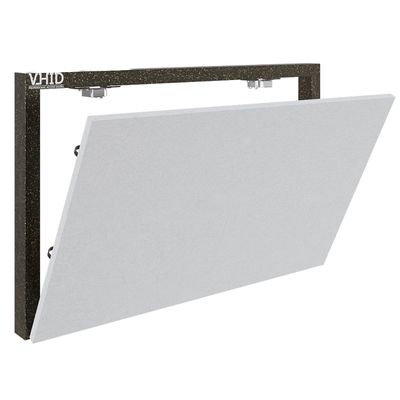[tab name='Made of black steel']
The Mechanic hatch is not equipped with shock absorbers, but it is easy to lift a lid of the hatch and immediately gain access to the niche in the floor. From above, the lid of the hatch is covered with a sheet of corrugated steel 3 mm thick, which enables it to withstand a load of up to 2 tons per 1 square meter of the lid surface. The Mechanic hatch is suitable for quick access to niches, pits and technical rooms in the floor both outside and in rooms where the issue of design is not important.
The hatch does not require additional lining, just install it in the opening and use.
The Mechanic hatch is made in two configurations of steel. For outdoor use, the hatch is made of AISI 304 stainless steel, with the lid thickness of 3 mm; for indoor or outdoor use, it is made of black steel covered with anti-vandal powder paint, with the lid thickness of 3 mm.
The black steel hatch is suitable for creating quick access to cables, water pipes, sockets or other communications on the floor of industrial, medical, warehouse or private premises where there is no excessive humidity and aggressive environment. It is not recommended to use the Mechanic hatch for access to residential basements and premises.
Stainless steel hatches are suitable for access to underground communications, water supply, sewage, communication lines, electric cables, outdoor pits. They are used in the creation of observation wells, sewage wells, entrances to technical rooms of swimming pools, artificial lakes where complete sealing is not required.
Important!!! The Mechanic hatch does not protect against water leakage. If you need such a hatch with full sealing, we recommend the D-rock model.
AISI 304 stainless steel (sheet and profile pipes) is used for the manufacture of the Mechanic hatch, which is processed by the method of chemical passivation. Additionally, stainless steel is polished with a glass jet. Glass jet processing removes residual stresses in welds, which are treated by the TIG method according to the international standard EN 10217-7.
In the second configuration, the Mechanic hatch is made of black electrowelded carbon cold-rolled steel (sheet and profile pipes) of the international standard ISO 630:1995, brand E235-B. The steel is treated with phosphates and coated with polyester powder paint. Welds are made by the MIG method according to the international standard DIN EN ISO 5817.
The design of the hatch consists of a frame and a lid that is inserted into the frame. Opening is manual with the help of removable handles.
The frame of the hatch is a branded L-shaped profile made of two steel profiles welded together with the dimensions of 20x20x1.2 mm and 20x40x1.5 mm (thickness of the profiles is indicated for black steel, it may differ for stainless steel). The 20x20x1.2 mm pipe is shifted 2 mm down relative to the 20x40x1.5 mm pipe to place the sealant on it. A corrugated steel plate with the thickness of 3 mm and the width of 50 mm is welded on top of the frame. This plate protrudes 30 mm from the contour of the frame and, during the installation of the hatch, is lowered to the rough floor. Its purpose is exclusively decorative.
Important!!! When calculating the size of the Mechanic hatch, a decorative plate protruding beyond the frame is not taken into account. The working dimensions are considered the landing dimensions, along the outer edge of the profile tube of the frame.
The frame of the lid is made of 20x40x1.5 mm steel profile. Its sides are interconnected by stiffeners, which strengthen and protect it from deformation under heavy loads. From above, the lid is covered with a sheet of corrugated steel 3 mm thick. The lid is inserted into the frame on a synthetic rubber gasket placed along the contour of the 20x20x1.5 mm tube of the frame. The sealant protects against the penetration of moisture, odors, and air. The hatch is not protected from water penetration, if necessary, choose the D-rock model.
The visible gap between the frame and the lid is 2 mm. The depth of the hatch structure in the closed state is 45 mm.
The hatch opens manually without additional lifting mechanisms.
To open the hatch:
To close, do the procedure in the reverse order: insert the lid back into the frame, unscrew the lifting handles, screw the decorative plugs in.
The minimum possible landing dimensions of the structure are 300x300 mm, the maximum ones are 1200x1200 mm.
The Mechanic hatch design corresponds to load class A15 (A15=1.5 t/m²).
Important! It is possible to walk freely on the hatch, and vehicles weighing up to 2 tons are allowed to run into it, but a load greater than the recommended one can lead to deformation of the frame of the lid over time.
When calculating the size of the Mechanic hatch, the decorative plate protruding beyond the frame is not taken into account. The working dimensions are considered the landing dimensions, along the outer edge of the profile tube of the frame. The landing dimensions equal to the outside dimensions with a decorative wing minus 30 mm on each side.
The recommended landing dimensions of the Mechanic hatch should be 10 mm smaller than the opening in the ceiling between the premises to allow for an installation gap.
The total depth of the hatch in the closed state is 45 mm.
Important!!! The clear/free opening of the hatch with one lid is less than the landing one by 80 mm in width and length.
Important!!! Installation of hatches is possible only in a horizontal position;
Important!!! In the standard configuration, hatches do not contain fastening elements or holes;
Important!!! The Mechanic hatches are installed exclusively after laying the finished floor covering;
Before starting the works, it is necessary to remove the lid of the hatch and not insert it until the frame of the hatch is completely installed.
1. Preparation of the opening
Prepare an opening of the correct geometric shape (rectangular or square) in the concrete or wooden floor, with 90° corners.
2. Fixing the hatch in the opening
The Mechanic hatch is installed exclusively in the middle of the opening in the concrete or wooden floor.
When the finishing lining material around the opening for the hatch has been laid, start installing the hatch. Calculate the level to which the hatch frame will be lowered so that the decorative overlay of the frame lies tightly on the finished floor covering. This will be an assembly line. Mark it on the walls of the opening.
Prepare steel angles for fixing the hatch (not supplied with the hatch). For each side of the hatch frame there should be at least 3 angles, with the dimensions of 40x40x3 mm. Fasten these angles with one side to the walls of the opening so that the other side is turned to the top and a shelf is formed at the level of the assembly line. You can fasten the angles in any convenient way: on 2-3 anchors, on reinforcement, by welding to a metal frame, etc. Lower the hatch frame without the lid onto the corner shelf and screw it with countersunk head screws. Make sure that the hatch is installed without distortions of the frame and in the same plane with the floor surface. The decorative overlay on the frame should lie tightly on the finished floor covering.
If there are still gaps between the finished floor and the decorative overlay on the hatch frame, fill them with cement or another fixing and sealing solution.
If an electric "warm floor" is used in the place of installation of the hatch, we recommend using steel anchors 60-100 mm long and 6-10 mm in diameter instead of angles. Choose the length and diameter of the anchors depending on the size of the hatch and the material that will be attached to the structure (the heavier the hatch, the stronger the required anchors). Install the anchors so that the distance between them is 200-300 mm.
After installing, securing and sealing the frame, insert the lid into it.
Important!!!
Before inserting the lid into the hatch frame, it is necessary to check that there are no foreign objects on the hatch frame, and that the sealant is correctly inserted;
3. Storage and transportation conditions
Important!!! Do not leave children unattended when the hatch is open, as it is a heavy construction with sharp metallic protrusions, so carelessness in its handling can lead to serious injuries and bodily harm. Be cautious!
Important!!! When closing the hatch, make sure that no children, domestic animals, birds or other living creatures are trapped between the frame and the door. They can be injured or killed when the hatch is being closed.
Warning!!! Black steel hatches may rust during operation.





